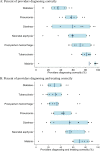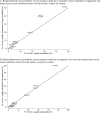Analysis of clinical knowledge, absenteeism and availability of resources for maternal and child health: a cross-sectional quality of care study in 10 African countries
- PMID: 33355259
- PMCID: PMC7751199
- DOI: 10.1136/bmjgh-2020-003377
Analysis of clinical knowledge, absenteeism and availability of resources for maternal and child health: a cross-sectional quality of care study in 10 African countries
Abstract
Objective: Assess the quality of healthcare across African countries based on health providers' clinical knowledge, their clinic attendance and drug availability, with a focus on seven conditions accounting for a large share of child and maternal mortality in sub-Saharan Africa: malaria, tuberculosis, diarrhoea, pneumonia, diabetes, neonatal asphyxia and postpartum haemorrhage.
Methods: With nationally representative, cross-sectional data from ten countries in sub-Saharan Africa, collected using clinical vignettes (to assess provider knowledge), unannounced visits (to assess provider absenteeism) and visual inspections of facilities (to assess availability of drugs and equipment), we assess whether health providers are available and have sufficient knowledge and means to diagnose and treat patients suffering from common conditions amenable to primary healthcare. We draw on data from 8061 primary and secondary care facilities in Kenya, Madagascar, Mozambique, Nigeria, Niger, Senegal, Sierra Leone, Tanzania, Togo and Uganda, and 22 746 health workers including doctors, clinical officers, nurses and community health workers. Facilities were selected using a multistage cluster-sampling design to ensure data were representative of rural and urban areas, private and public facilities, and of different facility types. These data were gathered under the Service Delivery Indicators programme.
Results: Across all conditions and countries, healthcare providers were able to correctly diagnose 64% (95% CI 62% to 65%) of the clinical vignette cases, and in 45% (95% CI 43% to 46%) of the cases, the treatment plan was aligned with the correct diagnosis. For diarrhoea and pneumonia, two common causes of under-5 deaths, 27% (95% CI 25% to 29%) of the providers correctly diagnosed and prescribed the appropriate treatment for both conditions. On average, 70% of health workers were present in the facilities to provide care during facility hours when those workers are scheduled to be on duty. Taken together, we estimate that the likelihood that a facility has at least one staff present with competency and key inputs required to provide child, neonatal and maternity care that meets minimum quality standards is 14%. On average, poor clinical knowledge is a greater constraint in care readiness than drug availability or health workers' absenteeism in the 10 countries. However, we document substantial heterogeneity across countries in the extent to which drug availability and absenteeism matter quantitatively.
Conclusion: Our findings highlight the need to boost the knowledge of healthcare workers to achieve greater care readiness. Training programmes have shown mixed results, so systems may need to adopt a combination of competency-based preservice and in-service training for healthcare providers (with evaluation to ensure the effectiveness of the training), and hiring practices that ensure the most prepared workers enter the systems. We conclude that in settings where clinical knowledge is poor, improving drug availability or reducing health workers' absenteeism would only modestly increase the average care readiness that meets minimum quality standards.
Keywords: child health; health systems; health systems evaluation; maternal health.
© Author(s) (or their employer(s)) 2020. Re-use permitted under CC BY-NC. No commercial re-use. See rights and permissions. Published by BMJ.
Conflict of interest statement
Competing interests: None declared.
Figures




Comment in
-
Extending the measurement of quality beyond service delivery indicators.BMJ Glob Health. 2020 Dec;5(12):e004553. doi: 10.1136/bmjgh-2020-004553. BMJ Glob Health. 2020. PMID: 33355260 Free PMC article. No abstract available.
References
-
- The National Academies of Sciences, Engineering and Medicine Crossing the global quality chasm: improving health care worldwide: health and medicine division. Washington, DC: The National Academies Press, 2018. - PubMed
-
- Kieny M-P, Evans TG, Scarpetta S, et al. . Delivering quality health services: a global imperative for universal health coverage (English) | the world bank. Washington, DC: World Bank Group, 2018.
-
- Björkman M, Svensson J. Power to the People: Evidence from a Randomized Field Experiment on Community-Based Monitoring in Uganda *. Q J Econ 2009;124:735–69. 10.1162/qjec.2009.124.2.735 - DOI
Publication types
MeSH terms
LinkOut - more resources
Full Text Sources
Medical
